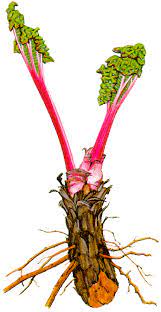
It was around this time of year that I baked my very first pie. I was 22 years old at the time, and a university student. Although I had baked cakes and cookies before, I had never yet attempted a pie. It just seemed too challenging. I preferred to stick with safer baked goods.
However, that summer I happened to be housecleaning for an older cousin of mine, and after my chores were done, she decided to show me how to make a pie. I remember carefully breaking up the butter into little crumbs and then mixing it together with the flour. My cousin watched over my shoulder the entire time to ensure that I had the correct ratio of butter and shortening to flour, knowing how important that was for the creation of a tender, flaky crust.
We then filled the pie with strawberries, and – you guessed it! – rhubarb from the garden. We sprinkled the strawberries and rhubarb with sugar, put it in the oven, and I have to say, that pie was pretty darn good!
But! We did not use rhubarb root. We used the tart, reddish coloured stems of the plant, to the great relief of both our palates and our intestines! For, while rhubarb stems are fibrous and tart, and no doubt good for the liver, the root is very bitter and yellowish, and is a highly regarded laxative for the intestines.
The Chinese pinyin name for rhubarb root is “Da Huang”, which means “Big Yellow”. Of all the yellow rooted herbs in Chinese medicine, this one is considered the most powerful, and the most yellow! When we make our GCG tincture, which includes rhubarb root, it tends to stain everything yellow. We have to be so careful of our clothes, since even bleach can’t eradicate a strong rhubarb stain.
So, why is rhubarb root considered “big and powerful”? Because it’s an excellent purger of heat, infection and stagnation in the lower body. It doesn’t just cool inflammation, as many other detoxifying herbs do, it also kills bacteria, stimulates blood circulation, and stops bleeding. It works well for people with strong constitutions, and yet is also gentle enough for people who are weaker. Basically, it covers pretty much any health problem in the lower body. It’s magnificent!
First, there are it’s well-known laxative properties. While other herbs, such as senna leaf, buckthorn bark, and even aloe vera leaf can purge a little too strongly and create cramping or laxative dependencies, rhubarb is gentler and can be taken for long periods of time without causing problems. This means that it works a little more slowly, with its effects not occurring until 6-8 hours after ingestion. However, because it doesn’t affect the small intestines, there is no issue with cramping, and it also doesn’t interfere with the normal ingestion of nutrients. [1]
It has broad spectrum antibiotic activity [2] and its ability to increase blood viscosity and stop bleeding make it an excellent remedy for bloody intestinal problems, like dysentery, or intestinal abscesses [3].
It protects the liver from damage, and increases the excretion of bile within just minutes of ingestion [4]. And its ability to stimulate blood circulation makes it an excellent herb for the heart, increasing oxygen consumption in the cardiac muscle, while also reducing heart rate and blood pressure [5][6].
Rhubarb root has even been used to successfully treat acute pancreatitis. In a study done with 100 patients who had pancreatitis, doses of straight rhubarb root – nothing else added – resolved the condition in almost 100% of cases after just 3 days. In this case, 30-60 grams of rhubarb root were given every 1-2 hours until symptoms subsided [7].
You can see why rhubarb root is revered in Chinese medicine. There’s plenty of reasons why you might want to keep some rhubarb root in your cupboard. Just make sure you don’t put it in your pies! You’ll be wanting to use the stems for that.
1. Zhong Yao Xue (Chinese Herbology), 1998; 251:256
2. Ibid.
3. Zhong Xi Yi Jie He Za Zhi (Journal of Integrated Chinese and Western Medicine), 1982; 2:85
4. Xin Yi Yao Xue Za Zhi (New Journal of Medicine and Herbology), 1974; (5):34
5. Chang Yong Zhong Yao Cheng Fen Yu Yao Li Shou Ce (A Handbook of the Composition and Pharmacology of Common Chinese Drugs), 1994; 226:323
6. Zhong Guo Zhong Yao Za Zhi (People’s Republic of China Journal of Chinese Herbology), 1989; 14(10):46
7. Zhong Xi Yi Jie He Za Zhi (Journal of Integrated Chinese and Western Medicine), 1982; 2:85
About the Author: Rebecca Wong has a BA in English Literature from the University of Waterloo and has been working in the herbal business since 2000. She studied at the Ontario College of Traditional Chinese Medicine under respected authorities Paul Des Rosiers and Vu Le, and graduated from the East West School of Planetary Herbology under Michael Tierra. She received training as a yoga teacher at The Branches in Kitchener/Waterloo, and therapeutic yoga teacher training from the School for Somatic Soulwork under Deniz Aydoslu. She now teaches yoga for anxiety, depression and burnout at Rebecca's Restful Yoga Studio in Toronto.